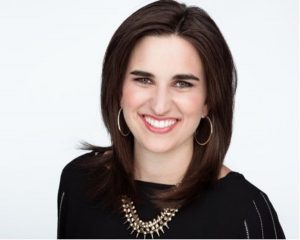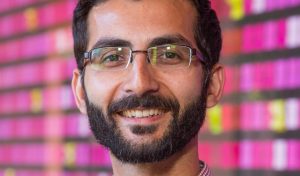Bridge Building Between Philanthropists and Marginalized Communities in Need
Her nonprofit organization, Impact Experience, seeks to bridge that gap, bringing together and creating relationships between investors, philanthropists, innovators, and leaders of marginalized communities. As an example, this past spring she led a group of Stanford students to Williamson, West Virginia, to work with a community there that has been heavily reliant on coal. Nicholas’s team only goes where they have been invited by the community, and there they lead what are called learning journeys, a collaborative process designed to build trust, map out opportunities and challenges, and then co-create solutions.

Being named a Social Innovation Fellow was a huge honor and will significantly impact the continued work of Impact Experience, Nicholas says. “Of course, the capital will be extremely helpful, but one of the things I am most excited about is having continued support and mentorship from the Center for Social Innovation,” she says. “We will have a point person at the CSI and weekly engagement throughout the year, as well as access to space here, to mentorship, to advisors. This is going to allow us to really scale the work we have been doing with marginalized communities. Some of the other communities Impact Experience has already been able to reach include Detroit, New Orleans, and Standing Rock, as well as internationally in India and Jordan.
Tackling Illiteracy in Pakistan Through a Two-Generation Approach
This year’s second SIF recipient is Muhammad Mustafa, a student in the MSx program whose first-ever trip to the United States was to attend Stanford. A native of Pakistan, he saw adult illiteracy as a pressing problem in his home country. “People understand the power of literacy—especially the illiterate,” he says. But what he discovered was that more than wanting to learn to read themselves, so many people he talked to in Pakistan desperately wanted to work—so that they could be sure that their children could go to school and have a better life.
And so Mustafa began to develop EasyJobs, a mobile app based entirely on icons and audio. Without knowing how to read, people in Pakistan can use the app to find much needed work. “Say you need someone to serve as a temporary caregiver in your home,” explains Mustafa. “You can make a request and it will go to people nearby, entirely in icons and audio that they can understand and respond to.”
As a Social Innovation Fellow, Mustafa can now return to Pakistan to establish EasyJobs first office in a slum where they can continue doing research and refining the app to best serve the needs of its target audience. “We will be living the life of the people who we want to impact,” he says. But for Mustafa, too, the money is secondary in importance to the mentorship he will receive from the CSI. “Had I just gotten funding from some organization, I would still be very scared and wouldn’t know how to proceed,” he says. “The mentorship CSI provides is really priceless—whether legal advice, product advice or just opening doors and introducing us to people. I still get all the resources of Stanford—get to hear what is happening at Stanford and my voice still gets heard at Stanford while I operate out of a slum in Islamabad. How many startups have that privilege?”
The Radiant Heart of the School
“Our community has been compared to the heart of the school—and I would go further to call it the radiant heart,” says Clavier. “We have really hard-core people who really, really deeply care about making a difference,” she says. Not everyone at the GSB is part of this community, she acknowledges. “But it is more than 25 percent of the class—and just imagine these people spreading out. That they make up a full quarter of the class means that every course is going to have these kinds of people in it, and they will nurture the conversation in a different way.”
Each of the award recipients we spoke to cited the strength and warmth of the social innovation community as a big part of the allure of the school. “Absolutely, that was one of the things I really liked about Stanford,” says Fernandez, who was also admitted to Harvard Business School. “It is very clear when you talk to Stanford students that impact is very important to them.” One of the things he admires most about his classmates is their willingness to take risks to do what they believe in, even if it means a pay cut. The passion and commitment of his colleagues also energizes him. “I can’t tell you how often I have been surrounded in a room by so much energetic stimulated brilliance and people want to work on something that they care about,” he says. “People are looking to dive into their true passions—and that really makes me want to recommit to what I am doing.”
Nicholas never even thought about applying anywhere other than the GSB. “Coming here for undergrad and seeing the orientation around social impact—the amount of focus there is with the Center for Social Innovation, classes, support from classmates, I actually didn’t consider any other business school,” she says. But even beyond the hardcore community of people focused on social change, she sees a heightened awareness and desire to do something meaningful with one’s life. “That is not to say that 100 percent of the students at Stanford are focused on that, but it is powerful to see how many people around me bring this lens of how do I use this platform as a way of serving society in some way.”

And for Mustafa, the pull of the CSI was huge, even from Pakistan. “I hadn’t met them, but I read everything I could find online and I knew this was exactly where I wanted to be—nowhere else,” he says. He didn’t learn about the Social Innovation Fellowship until sometime after he arrived and was encouraged by the CSI team to apply. “Never in my wildest dreams back in Pakistan could I have imagined I would be funded by Stanford to pursue this idea.”
The Tuesday evening celebratory ceremony made quite an impression on Mustafa as well. “We come across some really big names in our lives and some people we aspire to become—but to be in a room with so many of them altogether, and all of them caring so much about social impact and having done so much for it—it was a humbling experience,” he says.
But that single evening says so much more about the social innovation community at the school, he adds. “I really believe that Stanford is a really special place—people mistake it for being in the heart of Silicon Valley and therefore all about for profit. That is a misperception,” he says. “It is at the forefront of tech and innovation, but it is also at the forefront of social innovation and making an impact and creating leaders who are really cognizant of the world. That is an aspect of the business school that I don’t think is highlighted enough.”
Make no mistake. Stanford has and will continue to dominate attention-grabbing headlines for the insane salaries some of its graduates pull down—and many choose Stanford, or aspire to Stanford, for precisely that reason. But the PE and hedge fund hungry folks sit in classes side by side with Nicholas, Mustafa, Fernandez, and a growing number of others like them. “They are exposed to these guys and they come out the other end a lot more well-rounded—that’s part of why I call us the radiant heart of the school,” says Clavier. “This is a role that we play—it is completely informal, but it is real and it is crafting the culture of the school,” she says.
Miller’s Continuing Influence
“And it’s all made possible because Miller mandated the creation of a program like this when he was the dean,” says Clavier. “He opened the door to business being used for other purposes—and that was the seed for this growing into the community that exists today.”
That he made creation of the PMP a condition of his taking the deanship was the result of at least two deeply affecting personal experiences during his career as a businessman. As president of Ford Motor Company, Miller was called to Washington in response to Ralph Nader’s 1965 exposé of the automobile industry’s lack of concern about passenger safety. “We blew it,” Miller recalled on the Stanford website. “We really didn’t do so well. Businessmen just didn’t understand the political process, or how to deal with the new social demands that were starting to be placed on them.” Two years later, as chair of Detroit’s Economic Development Committee, he was charged with impossible task of bringing private-sector jobs to the riot-ravaged inner city. These two experiences helped clarify for Miller the desperate need for government leaders who understood business and business leaders who understood government—and for trust between the public and private sectors. Today’s “radiant heart of Stanford,” many would argue, was born from this.
Clavier says the Miller each year talks to students at the annual event about the issues he sees as most pressing in the world today. Top of mind for him recently have been global climate change and disengagement of youth with the political and democratic process. “He did say he was glad to see strong reengagement this year,” she shares.
Clavier hopes that Miller can continue to come to many more of these annual events. “Having him there—he plays the role of our guardian, anchoring us in our values,” she continues. “He was sitting at the honoree table and shaking the hands of all the awardees receiving a prize in his name—that is a key piece of making it really official and formal and important.
Mustafa says he was absolutely bowled over to be in Miller’s presence. “I actually had my son here and I took him over and asked, ‘Please can you shake the hand of my son?’ My 2-month-old son shook the hand of the 101-year-old Miller, and then he promptly fell asleep.”









